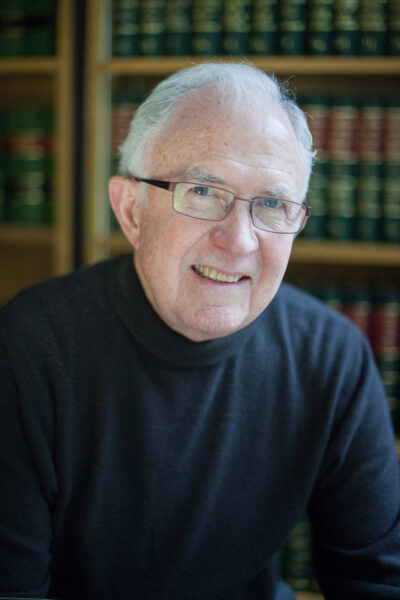To the best of my ability to determine when my father’s sperm cell united with my mother’s egg to conceive what in a short period of time became what I call “me”, it must have occurred close to Thanksgiving Day in 1939. I share this because for me personally and looking back on it, that moment on that day is one for which I am truly thankful. Who did this person become who entered the world outside my mother’s body on August 30, 1940? Some of you readers know or may know me now, but I am who I have now been after 83 years of life experiences, some as a follower of Christ at a later point in my life and some before that without Him.

In 1973 the case of Roe v. Wade was decided by the US Supreme Court determining that an abortion of a fetus could be lawfully performed under various criteria with respect to the choices of the mother to be and the state’s interests. Leading up to that decision while it was still pending in the court system, it had created a controversy in the public mind as to whether and if so when that procedure should be permitted under law. I can’t recall now when that controversy was being discussed and debated in public and private forums, but under Section 1 of the 14th Amendment to the Constitution, ratified in 1868, no state, as a matter of common or national law, could lawfully deprive any person of life without due process of law.
The Supreme Court in Roe v. Wade apparently declined, as it was undeterminable under the facts presented in the record of the case before it, to consider in its final decision whether a fetus at any stage was a person under the 14th Amendment restrictions and decided instead that the mother to be and the state’s rights under the process and decision were the only factors to be considered and permitted under guidelines or parameters. It was later modified in the Dobbs decision so that the common and constitutional law decision as a matter of law is now up to each state to determine that decision when contested by the parties. I have no further comment on these legal questions.
However, at the time and during the public controversy this raised in my mind a separate question that was not considered at all by the Supreme Court. I didn’t know for a long part of my life when an unborn child, called by science, the medical profession and most of us a fetus, becomes aware of its own existence in life, if at all, in that period between conception, as it is commonly called, and delivery into its life by birth. As I thought about these issues back then, Roe v. Wade, although established by early 1973, was still debated in the public and private arenas as well in later cases, it occurred to me that if we could objectively determine at what point in the continuum between conception and actual birth delivery an unborn child or fetus becomes aware of its own existence, wouldn’t that be an objective standard to determine and possibly assist the Courts in deciding when an unborn child or fetus becomes a person and thereby entitled to protection under the 14th Amendment? That question now remains with each state independent of how any other state regards that decision.
I have been a member of a Rotary Club for many years, probably beginning sometime after 1978 after I returned to the Pacific Northwest from Florida. As was then and remains customary, Rotary Chapters each week invite speakers on subjects of various public interest matters to present programs. At one such meeting in my Rotary Club in Kirkland, they had invited a doctor from a major hospital who specialized in birth and treatment concerns. She spoke that week of medical problems that arise during pregnancy for unborn children or fetuses and reported that tests are routinely performed to determine whether defects might exist in the unborn child’s genetic structure by a procedure called amniocentesis.
After the meeting I met and talked with her privately about her presentation. I asked her if she knew whether there have been any studies and conclusions from them reached as to what point in the continuum an unborn child or fetus is consciously aware of its own existence. My reason for considering this was to possibly find a way, in my own mind at least, to resolve this great and divisive question as to when an abortion should be permitted or prohibited before determining when that unborn child was or was not a person under the 14th Amendment.
Her answer astonished me in that she said, in effect, that she was not aware of any such studies or conclusions in medical science in that regard, but that she had an experience once that might interest me. I asked her to please tell me about it. She then proceeded to do just that. She reported that they were once doing a routine amniocentesis, a procedure on a pregnant woman designed to determine if there are any potential birth defects. This procedure involves a needle being inserted in the amniotic sack for the purpose of extracting fluids, from which a laboratory test could determine the likelihood of birth defects, if any, in the unborn child or fetus. She pointed out that if the final test showed that the fetus is free of such potential defects, the unborn child’s life, medically speaking, should be protected. The procedure is carefully observed by an ultrasound process so that the fetus or unborn child is not accidentally harmed by the sharp end of the fluid-withdrawing needle. She reminded me that at the stage when such tests are conducted, the fetus is able to and does move around in the amniotic sack completely immersed in fluid. The purpose of the ultrasound observation is to protect the life and body of the fetus if no potential defects are detected.
She then told me, as I recall it, that in the one procedure she was telling me about, the fetus was moving around and accidentally struck the sharp end of the needle with a part of its body and immediately withdrew its body away from the sharp end of the needle. She reminded me that inside the amniotic sack there is no light, so even with eyesight, the fetus could see nothing.
She then explained that the reaction of the fetus to the sharp end of the testing needle did not surprise her as she thought it was probably a muscle reaction response. She then told me what really did surprise her. The fetus immediately reached out with its hand, located the sharp end of the needle by touch only and quickly withdrew its hand, seemingly purposefully attempting to avoid avoiding any further contact. She had concluded, she told me, that in the context of my question, that the fetus was clearly aware of its own existence.
I was so startled by her answers that I didn’t even think to ask her at what point in the pregnancy continuum this incident occurred. I thanked her for her comments and our conversation was ended. My understanding now is that such procedures are usually performed between the 15th and 20th weeks of the 40 weeks of a normal pregnancy.
My point in relating this experience is to show that even before a normal birth by delivery, the unborn child as presented in this example was demonstrating that God’s plan was to create us as creatures with awareness of our even limited environment with the capacity to perceive events in that environment and even make limited movement choices that would later be expanded to comprehend the changing environment effects in normal life. The choices that can be made thereafter that effect and determine what each child will become in his or her life are more observable by others than this pre-birth test demonstrated. But I contend that it clearly shows that we are made by the process God designed and implemented and that we were made in His image in at least the sense of having the ability to choose in our thoughts and actions when confronted with life’s experiences. From that point on, life experiences, choices and memories derived from them influence who a child or your self becomes in your personal life. And since every person ever born and who reacts in various ways to life’s circumstances is different in most respects, the person you were born to be and have become is unique in this life. The famous playwright Oscar Wilde said, “Be yourself, everyone else is already taken.”
This explanation and my conclusion about it show that a child being born as it happens in the natural life with all of the genetic potential its parents provided in shaping it to be what it was at birth until changed by life’s circumstances is who he or she is or will become. This is so until the nature of each such person is changed by the process God provided through the sacrifice of Christ and the choice made by each individual under that opportunity to accept Christ and become that new person.
Jesus, according to the Apostle John, replied to a question by Nicodemus, a member of the Sanhedrin who came to him, and complimented him most likely rhetorically, calling him a teacher who came from God in order to perform the things he had been doing and asked him, was God with him and doing it? Jesus answered him,” I assure you and most solemnly say to you, unless a person is born again he cannot ever see the kingdom of God.” (John 3:3 Amplified version). That term thereafter has been freely used to describe who we are as persons in this life.
We experience the Kingdom of God only because we have accepted what Jesus as the Son of God, did for us by sacrificing His life to pay the price for our sins. From that moment on, we can humbly claim, as the phrase is commonly used, we have been given a new birth or in effect been “born again”. (Titus 3:5).
The Apostle Paul presented that we should not be conformed to the non-Christian world’s values but be transformed by the renewing of our minds so that you may test and approve that God’s plan for you is all along in accordance with His will. (Rom. 12:2). So as we walk through this life with a mind being transformed in every respect in terms of how we make decisions, trust or regard others, even strangers, and even loving respecting and forgiving others as God leads us, we have truly been born again from then on as we continue in following His plan for each of us.
The natural born person who has avoided, rejected or abandoned this Christian experience in his or her decision making is born in one sense, but those who accept what Christ did, and live it out thereafter are truly a different person and thereby born again to a different life. I am thankful He gave me that opportunity to be born again and that I took it.
Some time after two knee cartilage surgeries followed by a physical therapy protocol, one of those therapists and I were having a discussion and the subject of faith in God came up. I recall that I told him, in effect, “Just remember this, in my decision making daily in my life, I believe it is fair to describe it, in Christ my actions should be called as “we” did them because His Spirit became a part of me after I was born again, but when I was acting and deciding things in my life in the world without Him, it was just “me,” acting on my own.”
Therefore, in concluding this article, I urge you to consider that there are two different lives that persons are born capable of living, the natural one without Christ’s offer and the one that is new and different after that decision and being what we called “born anew of the Holy Spirit.” We who have accepted Christ have become to His honor and glory in that His plan for us is fulfilled (Col 1:27). We have thereby been truly “born again”.

John Woodbery Author. A retired lawyer, John writes novels, short stories, poetry, commentaries on legal subjects, even a song (!). Find his suspense novels on Amazon: Hidden, Earl’s Retreat, Two Tombs Covers.

Leave a Reply